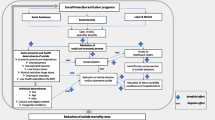Abstract
This paper contributes to the literature of suicide studies by presenting procedures and its estimates of the number of family members who lose their loved ones to suicide. Using Japanese aggregate level data, three main findings emerge: first, there are approximately five bereaved family members per suicide; second, in 2006, there were about 90,000 children who had lost a parent to suicide; and third, in 2006, there were about three million living family members who had lost a loved one to suicide. The direct production loss of bereaved family members in 2006 alone is estimated at approximately 197 million USD. These results are valuable in evaluating the cost-effectiveness of suicide prevention programs and in designing appropriate policy instruments.
Similar content being viewed by others
Notes
In this paper, family members are defined as the first degree relatives, that is, spouses, parents, siblings, and children.
Suicide victims of unknown age are excluded. This should not affect the estimates because they account for less than 1% of all suicide victims.
Marital status is classified into 5 categories: married, single, widowed, divorced, and unknown.
Data on the suicide victims are divided into 19 age groups up to age 90 years and above, while data on marital status are divided into only 17 age groups and up to age 80 years and above. To adjust for this difference, the same marital status was used for all suicide victims age 80 years and above.
The birth year for suicide victims was calculated by subtracting the mid-point of their age group from the year of suicide. Note that suicide victims of age 90 years and above were treated as people of age 92 years.
Whenever γ became larger than 1, it was set to 1. γ can be larger than 1 due to immigration and missing observations.
Data on population and birth rates are taken from “Population Statistics of Japan 2008,” published by the National Institute of Population and Social Security Research.
The average age of women at childbirth was calculated based on “Average Age of Women at Birth by Birth Order” in “Population Statistics of Japan 2008,” published by the National Institute of Population and Social Security Research.
Data on fertility rates are divided into 7 age groups from 15 to 49 years.
The average unmarried rates in 1995 and 2000 in Japan were taken from the “Census” of Japan Ministry of Internal Affairs and Communications (1995, 2000). The unmarried rate for suicide victims was taken from the “Vital Statistics’ Special Report” of the Japan Ministry of Health, Labour and Welfare. The data for other years were calculated through linear interpolation in a similar manner as Eq. 2).
By using this approach, children who lost a parent who was less than 30 years old are assigned an age of less than 0 years old. In these cases, the survival rate was set to one.
These data were taken from the “Prefectural life table 2000” (Japan Ministry of Health, Labour and Welfare 2003).
The “Prefectural life table 2000” shows that the probability of death for the elderly increases approximately in a geometric progression.
References
Chen, J., Choi, Y., & Sawada, Y. (2009). How is suicide different in Japan? Japan and the World Economy. doi:10.1016/j.japwor.2008.06.001.
Clayton, D., & Barcel, A. (1999). The cost of suicide mortality in New Brunswick, 1996. Chronic Diseases in Canada, 20(2), 89–95.
Coggan, C., Fanslow, J., Miller, B., & Norton, R. (1997). Economic costs associated with suicide and attempted suicide in New Zealand. Auckland: Injury Prevention Research Centre, Department of Community Health, University of Auckland.
Gunnell, D., & Frankel, S. (1994). Prevention of suicide: aspirations and evidences. British Medical Journal, 308(6938), 1227–1233.
Japan Ministry of Health, Labour and Welfare (1997). Vital statistics of Japan. Tokyo. Japan Ministry of Health, Labour and Welfare.
Japan Ministry of Health, Labour and Welfare (2002). Vital statistics of Japan. Tokyo. Japan Ministry of Health, Labour and Welfare.
Japan Ministry of Health, Labour and Welfare (2003). Prefectural life table 2000. Tokyo. Japan Ministry of Health, Labour and Welfare.
Japan Ministry of Health, Labour and Welfare (2004). Special report of vital statistics. Tokyo. Japan Ministry of Health, Labour and Welfare.
Japan Ministry of Health, Labour and Welfare (2006). Vital statistics of Japan. Tokyo. Japan Ministry of Health, Labour and Welfare.
Japan Ministry of Internal Affairs and Communications (1995). Population census. Tokyo. Japan Ministry of Internal Affairs and Communications.
Japan Ministry of Internal Affairs and Communications (2000). Population census. Tokyo. Japan Ministry of Internal Affairs and Communications.
Japan National Institute of Population and Social Security Research (2008). Population statistics of Japan. Tokyo. Japan Ministry of Health, Labour and Welfare.
O’Dea, D., & Tucker, S. (2005). The cost of suicide to society. Wellington: Ministry of Health.
Soeda, Y. (2001). On the children of suicide victims. In Y. Soeda & I. Shoten (Eds.), Sociology of death (pp. 195–210). Tokyo: Iwanami Shoten. in Japanese.
Soeda, Y. (2002). On the children of suicide victims reconsidered. Mother and Child Research, 22, 21–37. in Japanese.
U.S. Department of Health and Human Services (2001). National strategy for suicide prevention: goals and objectives for action.
World Health Organization (2000). Preventing suicide, a resource for general physicians, mental and behavioural disorders.
Acknowledgments
We would like to thank Hidehiko Ichimura and an anonymous referee for their comments. We also thank comments from Yasuyuki Shimizu of LiFELINK and members of “the White Paper on Suicide Prevention” project meetings supported by the Nippon Foundation. This research was supported financially by the Research Center for the Relationship between Market Economy and Non-market Institutions (CEMANO), a 21st Century Center of Excellence (COE) Program of the Graduate School of Economics at the University of Tokyo.
Author information
Authors and Affiliations
Corresponding author
Rights and permissions
About this article
Cite this article
Chen, J., Choi, Y.J., Mori, K. et al. Those Who are Left Behind: An Estimate of the Number of Family Members of Suicide Victims in Japan. Soc Indic Res 94, 535–544 (2009). https://doi.org/10.1007/s11205-009-9448-3
Received:
Accepted:
Published:
Issue Date:
DOI: https://doi.org/10.1007/s11205-009-9448-3




